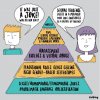Men’s rights advocates (MRAs) often argue that feminism portrays women as always and ever oppressed, and thus *makes* women into victims. Related to this, MRAs argue that feminist beliefs are harmful for women themselves. However, the actual evidence is that having feminist beliefs and/or a feminist identity is good for women, and that having feminist beliefs or a feminist identity has a range of positive benefits.
Michael Flood
Men’s responses to #MeToo, and other forms of feminist advocacy on rape and sexual harassment, range from enthusiastic support to hostile backlash. There are common forms of resistance among men to these campaigns, including defensive denials that men’s violence is routine, a focus on ‘other’ men, and complaints that #MeToo has ‘gone too far’. And for many men, there is simply mute discomfort. Masculinity is implicated directly in men’s perpetration of rape and sexual harassment, but also in men’s widespread inaction or complicity in the face of men’s violence against women.
Pornography has become the default sex educator for large numbers of young people. Viewing pornography is routine, especially among boys and young men, as two Australian studies document. Children and young people are encountering pornography in greater numbers, at younger ages, and with a wider variety of content.
Sexist jokes often are dismissed or excused as harmless fun. Yet they have real, negative effects in the world. They are linked to sexist and violent behaviour, they worsen gender inequalities, and they increase tolerance for violence against women.
We’re going to focus this morning on how to engage male students and staff on campus in violence prevention.
So I want you to think for a moment about the young men you see every day on your campus. The young men in your classrooms, in the cafeteria, in the college residences, and so on.
If these young men are typical of young men their age, then [...]
Please see the PDFs below for the remainder of this talk and the slides from the talk.
Also see:




